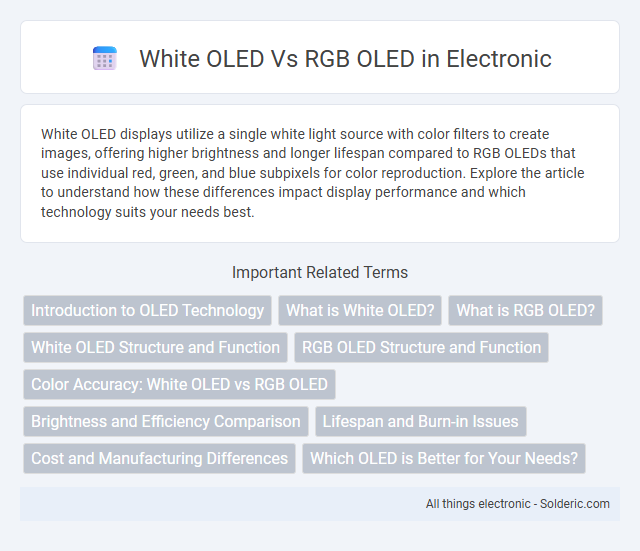White OLED displays utilize a single white light source with color filters to create images, offering higher brightness and longer lifespan compared to RGB OLEDs that use individual red, green, and blue subpixels for color reproduction. Explore the article to understand how these differences impact display performance and which technology suits your needs best.
Comparison Table
| Feature | White OLED | RGB OLED |
|---|---|---|
| Color Production | Uses white OLED with color filters | Uses individual red, green, blue OLED subpixels |
| Brightness | Higher brightness levels | Moderate brightness due to individual subpixel limits |
| Color Accuracy | Lower color accuracy due to filters | Superior color accuracy and saturation |
| Lifespan | Longer lifespan, less color degradation | Shorter lifespan, blue OLED degrades faster |
| Manufacturing Complexity | Simpler and cost-effective | More complex and expensive to produce |
| Power Efficiency | Less power efficient due to color filters | More power efficient with direct pixel emission |
| Typical Use Cases | Smartphones, TVs focusing on brightness | High-end displays needing color precision |
Introduction to OLED Technology
OLED technology uses organic compounds that emit light when an electric current passes through them, enabling thinner, flexible, and energy-efficient displays. White OLED (WOLED) emits white light through stacked layers with separate color filters, while RGB OLED uses individual red, green, and blue subpixels to create color directly. WOLED offers higher brightness and longer lifespan, whereas RGB OLED provides more vibrant colors and better pixel-level control.
What is White OLED?
White OLED (WOLED) technology produces white light by combining red, green, and blue organic emitters in a single layer or by stacking layers that emit white light, which is then filtered through color filters to create vibrant images. This approach differs from RGB OLED displays that use separate red, green, and blue subpixels for color generation, enabling simpler manufacturing and potentially longer lifespan due to reduced pixel degradation. Your display experience with White OLED often benefits from improved brightness uniformity and energy efficiency compared to traditional RGB OLED screens.
What is RGB OLED?
RGB OLED consists of individual red, green, and blue subpixels that emit light independently, allowing for vibrant color accuracy and high contrast ratios. Each subpixel in an RGB OLED display is a separate organic light-emitting diode, enabling precise control of color output and energy efficiency. This direct emission technology results in deeper blacks and sharper images compared to White OLED, which uses a white light source combined with color filters.
White OLED Structure and Function
White OLEDs utilize a multi-layer structure where blue, green, and red emissive materials are combined or a blue emitter is paired with a yellow phosphor to produce white light. This design allows for simpler pixel arrangements and can enhance efficiency by enabling color filters to create the full RGB spectrum on displays. Your choice of White OLED displays may benefit from improved brightness uniformity and longer lifespan compared to individual RGB OLED subpixels.
RGB OLED Structure and Function
RGB OLEDs consist of separate red, green, and blue organic layers that emit light individually, enabling precise color mixing for high-quality displays. Each subpixel in an RGB OLED is responsible for one primary color, allowing for vibrant and accurate color reproduction without the need for color filters. This structure supports efficient light emission and enhances contrast, making RGB OLEDs ideal for applications demanding superior image clarity and color fidelity.
Color Accuracy: White OLED vs RGB OLED
RGB OLED displays offer superior color accuracy by emitting pure red, green, and blue light directly, allowing precise color mixing and vibrant, true-to-life images. White OLED panels rely on a white OLED layer combined with color filters, which can result in slightly less accurate colors due to filtering light rather than emitting it in specific wavelengths. Your choice between White OLED and RGB OLED impacts color precision, with RGB OLED generally preferred for tasks requiring exact color reproduction such as professional photo and video editing.
Brightness and Efficiency Comparison
White OLED displays typically offer higher brightness levels due to their simpler light-emitting structure, which allows more efficient illumination across the entire screen. RGB OLED panels, while providing superior color accuracy through individual red, green, and blue emitters, often experience reduced brightness and efficiency as each pixel requires separate light generation. Your choice between White OLED and RGB OLED should consider that White OLEDs usually deliver better efficiency and brightness, making them ideal for high-visibility applications.
Lifespan and Burn-in Issues
White OLED displays typically offer longer lifespans than RGB OLEDs because they use a white OLED layer combined with color filters, reducing the risk of uneven pixel degradation. RGB OLEDs are more susceptible to burn-in issues since each pixel emits its own color light, leading to faster wear on blue subpixels and persistent image retention. Your choice between these technologies should consider the importance of durability and screen longevity, with White OLEDs generally providing better resistance to burn-in effects.
Cost and Manufacturing Differences
White OLED panels use a white emitter combined with color filters, resulting in simpler manufacturing processes and lower production costs compared to RGB OLEDs, which require precise placement of individual red, green, and blue subpixels. RGB OLED displays deliver higher color accuracy and brightness but involve more complex fabrication techniques that elevate manufacturing expenses. If you prioritize cost efficiency, White OLED technology offers a more affordable solution without significant compromise in visual quality for most applications.
Which OLED is Better for Your Needs?
White OLED panels offer higher overall brightness and longer lifespans, making them ideal for environments requiring vivid display and durability. RGB OLEDs deliver superior color accuracy and deeper blacks, which benefit applications demanding precise color reproduction and contrast. Your choice between White OLED and RGB OLED depends on whether you prioritize brightness and longevity or exceptional color performance.
White OLED vs RGB OLED Infographic

 solderic.com
solderic.com